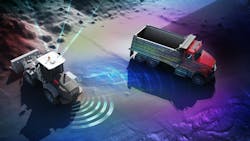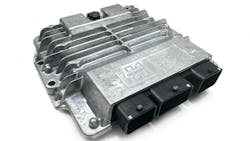Automation Brings New Technology Requirements for Fluid Power Systems
Fluid power technologies are evolving to meet the needs of automated systems and machines in both industrial and mobile machinery applications. The increased precision and accuracy required is bringing about a number of technological developments, including more software and electronic control.
Power & Motion spoke with three experts from the fluid power industry to learn more about how automation is influencing hydraulics and pneumatics designs:
- Adam Khaw, Head of Autonomy, Danfoss Power Solutions
- Daniella Gonzalez, Product Market Manager Pneumatic and Electro-Pneumatic Valves and Valve Terminals, Festo Corporation
- Ben Holter, Product Director at Husco International.
These industry experts offer their insight on how they are seeing automation uptake increase, technological developments occurring due to automation as well as opportunities they see for fluid power as this trend continues to grow.
*Editor’s note: Questions and responses have been edited for clarity.
Power & Motion: Has your company seen an uptick in requests from customers for solutions that will aid their automation efforts? If so, what is driving this?
Adam Khaw: Yes, especially in construction, mining, and airport ground support. Across these sectors, there is growing demand driven by labor shortages, operator turnover, and the high cost of mistakes. In mining and construction, mistakes can lead to injuries or machine downtime. In ground support, they can result in costly aircraft damage.
Customers are turning to automation to improve safety, reduce errors, and make operator tasks more manageable. At Danfoss, we’re focused on delivering the full autonomy system: hydraulics, safety-rated controllers like the SC50, our XM100 autonomous controller, and prebuilt autonomy software through our PLUS+1 Autonomous Control Library (ACL). We also offer ACES, our Autonomous Custom Engineering Services, to help customers implement and scale these systems efficiently. It’s all part of our Delivered Autonomy strategy.
It’s increasing steadily across off-highway equipment. Engineers are now designing for machines that need to understand their environment and act with precision. That shift changes how we think about every system, from core hydraulics to controllers and software. Tools like the XM100 and ACL make it easier to build autonomy into the foundation of the machine, not as an afterthought.
Daniella Gonzalez: Yes, our customers are looking to improve their automation efforts. Over 80% of our customers are using automation.
I believe innovation is a big part of it. With IoT (Internet of Things) becoming more popular, it allows our customers to have better quality due to improved processes because of condition monitoring.
Ben Holter: It's an interesting time to be in the industry. Automation has been omnipresent for the last 15 years, and this omnipresence has been through kind of a roller coaster of [needing] automation, but then they [original equipment manufacturers (OEM)] realize they also need GNSS (Global Navigation Satellite System), IMUs (inertial measurement units), displays, edge processing, cloud connectivity [and] site planning. So, it's always been kind of ‘Hey, we're ready now’ and then they realize the next thing that's either not ready, too expensive, or not rugged enough.
And so, hydraulics have been ready for decades for automation, but we've really been waiting for this convergence of technology to make it possible for our customers to take advantage of it. The requests for automation [have not risen], but the actual being able to automate has. We've seen the upticks happening now that we're, I think, finally off the starting line and really into the race now, because everything else has now become capable. It didn't make sense to buy a more expensive hydraulic valve because nothing else was ready, but now that everything else is ready — the sensors, the machines, the site planning — [OEMs want to buy] the new hydraulics. We're not seeing a new uptick in requests, but we're seeing a new uptick in actual viability and production of hydraulics to enable that.
Power & Motion: How are hydraulic and pneumatic technologies evolving to meet the needs of automation?
Adam Khaw: Hydraulics are evolving into digitally controlled, intelligent systems. We’re combining proven hardware like PVG valves and EHi steering with advanced control platforms like the SC50 for safety and XM100 for autonomy. Our Autonomous Control Library provides prebuilt, validated software blocks for perception, navigation, and control.
The challenge is bringing all of this together into a system that is both rugged and intelligent. That’s where ACES comes in. Our team works alongside customers to help integrate and deploy these solutions effectively. Delivered Autonomy isn’t just about components, it’s about making the system work from day one.
Daniella Gonzalez: Festo is evolving by focusing on more than just pneumatic solutions with innovative solutions like “Controlled Pneumatics” where we have added condition monitoring to traditional pneumatics. This expanded range of technologies allows Festo to provide the customer with a variety of solutions that will provide the correct one for their needs.
Ben Holter: Most of the integration of sensors is onto the machine…adding the electrohydraulic, the solenoid — the digital to hydraulic interface — is all we have to do. It's a rather small change, but then how to control it is what is really complex. We add these little cartridges that take an electrical signal and output a hydraulic flow. And then we add controllers to control [the valve], rather than having a lever connected from the joystick to the actual valve itself and having that mechanical linkage. Now it's [determining what] the operator wants, figuring it out with a bunch of logic in the controller and outputting that to the control signal.
Husco has done a really good job that our same exact valve, all you have to do is machine a different port, and now it can be mechanical, it can be pilot, or it can be electrohydraulic. We're trying to make a simpler bridge from what you have today to the future. So, if you're not quite ready [for automation], work with what you have, but then when you are ready, just change this little bit [and] you don't have to change hose routing, mounting, anything like that. It's really been helping make an easy transition to automation once each OEM is ready for it.
Power & Motion: What challenges do you or the fluid power industry as a whole face when developing and/or implementing automation solutions?
Daniella Gonzalez: One of the big challenges is integration and compatibility with existing systems. Ensuring that new automation solutions can seamlessly integrate with legacy systems and existing infrastructure can be complex and costly. This, I think, is one of the spaces where Controlled Pneumatics shines because while being innovative and providing additional benefits, it uses the same familiar concepts as traditional pneumatics with condition monitoring for the systems.
Ben Holter: There’s tons of challenges; I like to call them opportunities. The first challenge I always run into is hydraulics are old. Hydraulics are dirty. Hydraulics can’t be automated. You hear that all the time [from] different companies — hydraulics have been around for 60 years, and they just can't [be automated]. And the truth of the matter is, we provide value to our customers, and if EH (electrohydraulic) isn't a value because automation is not ready or efficiency isn't needed, and it's really cost is king, then we're not going to add features or add costs if it's not valuable to our customers. We've had automatable valves. We've had all this stuff for 20+ years, it just hasn't been valuable to our OEMs, so we haven't mass produced it. People just assume because hydraulics don't do it today, that they can't, which is so far from the truth. It just hasn't been of value…[but] it's totally capable.
The last 5 years of my life has been sharing with people how different the mobile electronics are versus industrial electronics. In the mobile space I have to live in [voltages and temperatures that may be] varying constantly; that means the physics of my solenoid is changing all the time. If you're not accounting for voltage changes, if you're not taking into account the temperature variation of the machine, you might be off by a couple milliamps. That couple milliamps on the control side of the electrohydraulics might change the output power of the cylinder by a kilowatt; on a normal size excavator, one milliamp ends up being about 1 kW of output power, which if you don't account for that, you might be off grade by 100 mm. Generally, we want 25 mm of accuracy.
So, I think what's difficult is [OEMs] don't appreciate the knife edge stability that we've tuned hydraulics to and made hydraulics work for so long to match costs, quality and performance, and because of that, it's become a very difficult system to automate. Not impossible, you just really have to dive down into the details. The alternator is fluttering, that matters; the temperature is changing, that matters; the coil is heating up, that matters. A lot of it comes down to us needing to really fine tune the controls and really understand the control system. And so, the opportunity is, in order to be really good at automation, you have to understand machines, you have to understand hydraulics, you have to understand electronics, and you have to understand software. That's where [Husco comes in]; we provide a controller that has a lot of that underlying knowledge of the electrical system and the software in it. We're good at hydraulics, so we can give you this hydraulic control unit, kind of like an ECU (engine control unit)...that makes hydraulics easier to automate, so that way you [the OEM] can focus on your value add, and we'll give you our value add along with it.
Power & Motion: Are you seeing other technologies, such as electric actuators, being used in place of hydraulics and pneumatics as systems and machines become more automated? What are these technologies and what advantages do they offer?
Adam Khaw: Yes. In steering and drive systems, electric actuators are becoming more common, especially where tight control and low maintenance are priorities. Our Editron electric drivetrains and EHi steering systems are good examples. These technologies integrate well with autonomous systems and are fully supported by the XM100 and ACL software framework.
They are replacing smaller hydraulic functions, especially where space, precision, or service simplicity is important. Electric actuation enables smooth, responsive control and integrates easily with autonomy stacks. For example, in ground support, electric steering combined with the XM100 and ACL helps improve docking accuracy, protects the aircraft, and reduces cognitive load on the operator. It’s not just about the actuator; it’s the value of a coordinated system delivering consistent results.
Daniella Gonzalez: Yes, we see an increased demand for electric actuators and controlled pneumatics solutions. Some applications have more than one way to solve them, with traditional pneumatics, electric automation, Controlled Pneumatics as well as ‘hybrid’ solutions, Festo’s approach is to find the best solution for the application, allowing all our technologies to coexist in customer’s systems.
Some advantages that are typically associated with electric actuator solutions can be energy efficiency, precision and control, compact design, and integration with digital systems. And here I think it’s worth mentioning that the Controlled Pneumatics options that Festo has offer solutions with these benefits as well. With products like our Motion Terminal VTEM, or our new flow control terminal VTEP, we can get precision and motion control like you typically see in electric automation, but using a lot of the same pneumatic components already designed in the system, at a smaller footprint.
Ben Holter: Yeah, where we're seeing them. The thing is, the power density [and] robustness of hydraulics are so good. I'm not going to say that in 20 years, it's not going to change, but right now the value of hydraulics is hard to beat in certain machines. Now, there's going to be certain parts of a machine, [such as] a quick hitch, that absolutely I would love to become linear actuators, because it makes the hydraulic system less complex. I think there's a lot of places where we could actually add value by taking out hydraulics.
Read More About Automation Technology and Trends
How Automation is Impacting Hydraulic and Pneumatic Designs
Pneumatics a Key Piece of the Automation Puzzle in Packaging Applications
Uptime and Automation Among Key Design Objectives for Industrial Machinery
The 5 Levels of Autonomy in Off-Highway Equipment
Choosing the Right Linear Actuator to Boost Automation System Performance
Electrification and Automation Will Bring Productivity Gains to Construction
Where we see benefit is when OEMs take a pragmatic approach…really look at hydraulic systems [to see where adding] a small actuator would work and gets rid of a whole bunch of hose routing and [other components]. I think those are the really useful spots where it makes sense and we'll see more of that happen. Think about joysticks. They used to be pilot operated, so you had to bring hoses up into the cab. That caused noise, heat, and dust to ingress. When they moved to an electric joystick, now it's easy to route, it's less manufacturing, it's one cable to install, it's less hose costs, less noise, it's nicer for the operator, they can spin the cab around now. That was a huge thing that's happening right now [and] removing hydraulics, but it's making the hydraulic system better. So I think we have to realize that electronics are going to take over hydraulics in certain spots, and it's going to make a whole lot of sense, and it's going to help move the industry forward.
Will it take over an entire machine? In certain cases, yes, such as AWP (aerial work platform); there's certain spots that it makes sense, where the ruggedness, the environment, the number of functions [make it feasible]. But I think that the core, earthmoving construction machines that we see are going to be mainly hydraulic at least for a while.
Power & Motion: Do you see opportunities for the fluid power industry as automation progresses? If so, what are these opportunities and what further technological developments are needed to meet the requirements of automation?
Adam Khaw: Yes, and those opportunities are accelerating. Fluid power remains the best solution for moving heavy loads with speed and control. As automation progresses, there’s demand for systems that are easier to control, monitor, and adapt. Danfoss is leading the way with the PLUS+1 ecosystem, XM100 controller, ACL software, and engineering support through ACES. Whether it’s automating crane cycles, optimizing haul routes in mining, or supporting GSE near aircraft, it’s the integration of hydraulics, electronics, and autonomy software that unlocks real value. That’s what we build every day. That’s Delivered Autonomy.
Daniella Gonzalez: Yes, as automation progresses, several opportunities arise in the industry. A few to list of are:
- Increased efficiency – Automation can streamline processes, reduce downtime and increase production speed.
- Cost reductions – Minimizing labor costs and reducing errors.
- Enhanced precision and quality – By automating systems, you can create more consistency and precision in manufacturing, improving product quality.
- Data driven insights – This is especially important when integrating with IoT and data analytics, allowing customers to gather and analyze data for better decision making and predictive maintenance.
- Flexibility and customization – Allowing the systems to be more flexible and adapt easily to market demands.
- Enhanced Safety – Automation can reduce the risk of workplace accidents by taking over dangerous tasks, improving overall safety in industrial environments.
To meet these new requirements of automation, investing in concepts like energy efficiency, improved IoT connectivity, machine learning, data analytics and enhanced simulation tools will be crucial for industries to fully leverage the benefits of automation and adapt to evolving market demands.
Which is why Festo is investing in solutions that include Controlled Pneumatics, where some benefits are precision control, energy efficiency, integration with automation systems, improved responsiveness, reduced maintenance, compact design, flexibility and adaptability.
Overall, Controlled Pneumatics is enhancing the efficiency, reliability, and versatility of automated systems, making it a valuable component in the ongoing evolution of the automation industry and Festo’s offering.
About the Author
Sara Jensen
Executive Editor, Power & Motion
Sara Jensen is executive editor of Power & Motion, directing expanded coverage into the modern fluid power space, as well as mechatronic and smart technologies. She has over 15 years of publishing experience. Prior to Power & Motion she spent 11 years with a trade publication for engineers of heavy-duty equipment, the last 3 of which were as the editor and brand lead. Over the course of her time in the B2B industry, Sara has gained an extensive knowledge of various heavy-duty equipment industries — including construction, agriculture, mining and on-road trucks —along with the systems and market trends which impact them such as fluid power and electronic motion control technologies.
You can follow Sara and Power & Motion via the following social media handles:
X (formerly Twitter): @TechnlgyEditor and @PowerMotionTech
LinkedIn: @SaraJensen and @Power&Motion
Facebook: @PowerMotionTech

Leaders relevant to this article:










